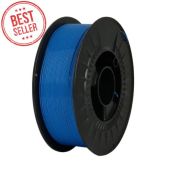We use cookies to make your experience better. Read more
-
What is ASA Filament
30 August, 2024WeiterlesenWhat is ASA Filament - Everything You Need to Know
Introduction to ASA Filaments
ASA filaments, also known as Acrylic Styrene Acrylonitrile, are a popular choice among 3D printing enthusiasts, particularly for outdoor applications. With superior UV resistance, chemical resilience, and durability, ASA filaments stand out as a robust option for creating parts that need to withstand harsh environmental conditions. This guide will walk you through everything you need to know about ASA filaments, from their composition and properties to practical printing tips and troubleshooting advice. By the end of this article, you'll have a thorough understanding of how to achieve the best results with ASA filaments.
What Are ASA Filaments?
ASA filaments are engineering thermoplastics with a molecular structure closely related to ABS (Acrylonitrile Butadiene Styrene). However, ASA filaments offer enhanced UV resistance, making them an excellent choice for outdoor 3D prints. The primary composition of ASA
-
What is ABS Filament
15 August, 2024WeiterlesenWhat is ABS Filament - The Essential Guide to 3D Printing
Introduction to ABS Filament
Acrylonitrile butadiene styrene, commonly known as ABS, is one of the most widely used materials in 3D printing. As a thermoplastic polymer, ABS filament is favored for its durability, strength, and versatility. Since its patenting in 1948, ABS has found applications across numerous industries, including automotive, construction, and consumer goods. This article delves into the composition, properties, and uses of ABS filament, highlighting why it remains a top choice for 3D printing enthusiasts and professionals alike.
Composition and Properties of ABS Filament
ABS is composed of three primary monomers: acrylonitrile, styrene, and butadiene. Each of these monomers contributes unique properties to the final product:
- Acrylonitrile: Provides rigidity, strength, and chemical resistance.
- Styrene: Adds a smooth, shiny texture.
- Butadiene: Contributes toughness and flexibility, making ABS particularly resilient.
-
What is PETG Filament
12 August, 2024WeiterlesenWhat is PETG Filament - The Ideal Choice for Durable 3D Prints
What is PETG?
Polyethylene Terephthalate Glycol modified (PETG) is a synthetic thermoplastic polyester renowned for its exceptional chemical resistance, durability, and excellent formability. PETG is an incredibly versatile filament that balances mechanical properties with ease of printing, making it a popular choice for various applications in 3D printing. Its ability to offer good light diffusion and strong layer adhesion has led to its widespread use in manufacturing prototypes, functional parts, and even decorative items.
While PETG is a derivative of PET, it's important not to confuse it with other variations such as PETP (“pure PET”). PETG's glycol modified component provides distinct benefits, including enhanced clarity and ease of extrusion, which are critical for achieving high-quality prints.
PETG in 3D Printing: Applications and Benefits
Versatile Applications
PETG is widely used in vacuum and pressure forming applications
-
What is PLA Filament?
10 August, 2024WeiterlesenWhat is PLA Filament? A Beginner’s Guide to 3D Printing Materials
Understanding PLA Filaments
PLA (Polylactic Acid) is one of the most widely used 3D printer filaments, known for its versatility, extensive color range, and aesthetic appeal. PLA is particularly favored by those seeking high-quality, vibrant, and visually pleasing 3D prints. Its ease of use makes it an ideal choice for beginners looking to experiment with 3D printing. But what exactly makes PLA one of the best filaments for 3D printing?
What is PLA Filament?
PLA filament is an eco-friendly 3D printing material derived from organic sources such as corn starch and sugarcane. The production of this thermoplastic monomer is what sets it apart from other filaments, as it uses biomass resources, making it both sustainable and environmentally friendly. PLA is biodegradable, requires 65% less energy to produce compared to traditional plastics, and emits 68% fewer greenhouse gases during production. Additionally, it does not contain



Please complete your information below to login.
Anmelden
Neuen Account erstellen